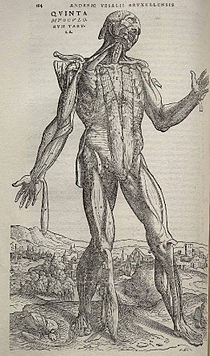- De humani corporis fabrica
-
De humani corporis fabrica libri septem (On the fabric of the human body in seven books) is a textbook of human anatomy written by Andreas Vesalius (1514–1564) in 1543.
The book is based on his Paduan lectures, during which he deviated from common practice by dissecting a corpse to illustrate what he was discussing. It presents a careful examination of the organs and the complete structure of the human body. This would not have been possible without the many advances that had been made during the Renaissance, including both the artistic developments and the technical development of printing. Because of this, he was able to produce illustrations superior to any that had been produced up to then.
Fabrica rectified some of Galen's worst errors, including the notion that the great blood vessels originated from the liver. Even with his improvements, however, Vesalius clung to some of Galen's errors, such as the idea that there was a different type of blood flowing through veins than arteries. It was not until William Harvey's work on the circulation of the blood that this misconception of Galen would be rectified in Europe.
Vesalius had the work published at the age of 28, taking great pains to ensure its quality. The illustrations are of great artistic merit and are generally attributed by modern scholars to the "studio of Titian" rather than Johannes Stephanus of Calcar, who provided drawings for Vesalius' earlier tracts, but in a much inferior style. The woodcuts were greatly superior to the illustrations in anatomical atlases of the day, which were often made by anatomy professors themselves. The woodcuts were transported to Basel, Switzerland, as Vesalius wished that the work be published by one of the foremost printers of the time, Joannis Oporini. The illustrations were also created using engraved copper plates (called intaglio), which allowed for very fine detail (see 'Scientific Revolutions' by Brian S. Baigrie, pages 40-49 for more information and a translation of Vesalius' preface).
The success of Fabrica ensured the health of Vesalius' coffers, and in time, fame. He was appointed physician to the Holy Roman Emperor Charles V; Vesalius had dedicated the work to the ruler, and presented him with the first published copy (bound in silk of imperial purple, with specially hand-painted illustrations not found in any other copy). The Fabrica was republished in 1555.
A copy of the book clad in human skin was donated to Brown University's John Hay Library by an alumnus. Its cover is "polished to a smooth golden brown" and, according to those who have seen the book, it looks like fine leather. Covering books in human skin was not an uncommon practice a couple of centuries ago, utilizing the skin of executed convicts and poor people who died with no one to claim the body.[1]
Of pharmacological interest, Fabrica mentions Digitalis, which is still an important Inotropic Agent used to treat congestive heart failure.
References
- ^ Johnson, M.L. (2006-01-08). "Libraries own books bound in human skin". The Barre Montpelier Times Argus. The Associated Press. Archived from the original on 2006-08-10. http://web.archive.org/web/20060810191350/http://www.timesargus.com/apps/pbcs.dll/article?AID=/20060108/NEWS/601080346/1003/NEWS02. Retrieved 2009-10-06.
Bibliography
- O'Malley, CD. Andreas Vesalius of Brussels, 1514-1564. Berkeley: University of California Press, 1964.
- Vesalius, A. De humani corporis fabrica libri septem [Title page: Andreae Vesalii Bruxellensis, scholae medicorum Patauinae professoris De humani corporis fabrica libri septem]. Basileae [Basel]: Ex officina Joannis Oporini, 1543.
- Vesalius, Andreas. On the Fabric of the Human Body, translated by W. F. Richardson and J. B. Carman. 5 vols. San Francisco and Novato: Norman Publishing, 1998-2009.
External links
 Media related to De humani corporis fabrica at Wikimedia Commons
Media related to De humani corporis fabrica at Wikimedia Commons- Turning the Pages Online. A U.S. National Library of Medicine project to digitize images and plates from "rare and beautiful historic books in the biomedical sciences".
- Andreas Vesalius. De Humani Corporis Fabrica. Historical Anatomies on the Web. Selected images from the original work. National Library of Medicine.
- De Humani Corporis Fabrica online — translated with full images, from Northwestern University
Categories:- 1543 books
- Science books
- History of anatomy
- History of medicine
- 1543 in science
Wikimedia Foundation. 2010.


